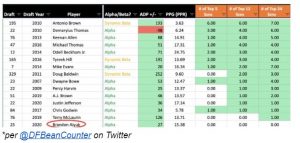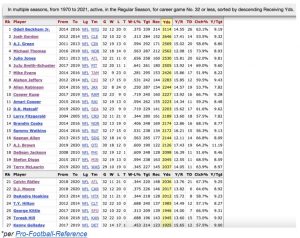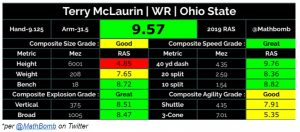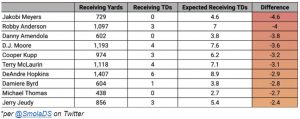[brid autoplay=”true” video=”852237″ player=”10951″ title=”RZBL%20FB%202021%20FFF%20WRs” duration=”146″ description=”undefined” uploaddate=”2021-08-27″ thumbnailurl=”//cdn.brid.tv/live/partners/9233/thumb/852237_t_1630044636.png” contentUrl=”//cdn.brid.tv/live/partners/9233/sd/852237.mp4″]
Expectations were low for McLaurin as a third-round selection out of Ohio State. He was the definition of an outlier—poor college resumé, underwhelming analytics profile, and returned for his senior year. Furthermore; he was a 24 year-old rookie, without a registered Break Out Age. Yikes.
Guys like that aren’t supposed to succeed, but he wasted no time proving everyone wrong, posting 125 receiving yards and a touchdown in his first-ever NFL game. He should’ve had 198 yards and two touchdowns, but Case Keenum badly overthrew McLaurin on a double move after torching the poor Eagles secondary. Go figure.
He posted one of the best rookie seasons ever by a WR drafted in round three or later. Compare his numbers to the leaders in yards among WRs with similar-or-worse draft capital:
Two of those guys turned out to be pretty good if memory serves. Fighting with low-quality QB play and minimal pass volume (Washington threw only 29.9 times per contest in 2019, 28th in the NFL), McLaurin did plenty to impress anyone who noticed.
He also posted the seventh-highest Yards per Route Run (YPRR) ever by a rookie WR with 350 or more routes run, with 2.06 (ranked 19th in the NFL). YPRR is often a strong indicator of future success, and McLaurin checks that box. He didn’t just produce at a high level, he impressed PFF as well. I know, grades are subjective, just bear with me.
Top-Five Upside
McLaurin received a PFF grade of 85.7 in 2019. It was the highest grade among rookie WRs in 2019, and the fourth-highest grade among rookie WRs over the last decade, only being bested by Odell Beckham Jr., Justin Jefferson, and Michael Thomas.
This may not seem significant initially, but after examining other rookie receivers who posted a grade of 80+, it becomes clear it can be taken as a signal.
This list doesn’t miss. Excluding McLaurin, along with rookie standouts Brandon Aiyuk and Justin Jefferson, each of these receivers went on to produce at least one top-12 fantasy season. Going even deeper; 66% had multiple top-12 finishes, and 75% of them had a top-five season.
Also worth noting; McLaurin led all rookie WRs in 2019 in fantasy points per game. Yes, that includes A.J Brown and D.K. Metcalf. This is especially impressive considering Brown and Metcalf played in highly-functional offenses with above-average QB play.
Alpha Status
Let’s forget about third-round-or-later guys and PFF grades; McLaurin is a true alpha WR in the NFL, as evidenced by his 23.01% target share in his rookie year, which was the third-highest by a rookie since 2015. He also posted the league’s second-highest Dominator Rating (percentage of yards and touchdowns the player accounts for in the offense) in year one, at 36.7%.
His target share jumped to 25.5% in year two, similar to other alpha WRs such as Allen Robinson or Keenan Allen. In weeks one through nine, he had a 27.3% target share before Alex Smith majorly crippled the Washington offense, and McLaurin suffered two simultaneous ankle injuries.
Basically; McLaurin forced himself into being the focal point of the offense like many WR1s before him. Here’s how McLaurin’s first two seasons of production stack up against all currently active NFL WRs:
Cracking the top-20 should be enough to impress, but notice how McLaurin only played 29 games, as opposed to 32 for almost everyone else. His average pace would elevate him to ninth overall, had he missed no time.
Through his first 29 games, McLaurin has finished with 60 or more receiving yards in 19 of them. That number ranks fourth among WRs in their first 29 games since 2005, and trails only Odell Beckham Jr., Julio Jones and Michael Thomas.
How did McLaurin manage such an impressive start in Washington, of all places? It starts with elite athleticism.
Physical Tools
McLaurin provides alpha size, checking in at 6-0, 208 pounds, and a BMI of 28.78. To get an idea of how athletic he is, here’s a look at his Relative Athletic Score. (“RAS” is a relative, comparative metric that shows athleticism on a 0-10 scale based on 10 combine measurements compared to position)
A score of 9.57 firmly places McLaurin in MathBomb’s “elite” category, after charting over 2,400 receivers since 1987. Clocking in with a 4.35 40 yard dash (97th-percentile), McLaurin possesses legit track speed. His “great” Speed/Explosion grades show up on the field and help him make big plays, after utilizing his rock solid 37.5 inch vertical.
McLaurin’s 18 bench reps were 78th-percentile, and that strength packed into a “shorter” frame helps him break tackles for chunk gains after the catch. He’s a high-end athlete, who knows how to use his physical gifts to his advantage.
Contested Catches
Watching him play, folks wouldn’t guess McLaurin scored in the 36th-percentile or worse in arm-length, wingspan and hand size. Per PlayerProfiler, he led the entire NFL with a 68.4% contested catch rate…as a rookie.
Since 2019, he’s tied for seventh in most receptions for 20+ yards with 32. And, per PFF, McLaurin is tied for the second-most contested catches on passes of 20+ yards downfield with 10. As a legitimate deep threat with elite hands, McLaurin makes the most of every opportunity. However, what he does after the catch is what’s really exciting.
YAC-Machine
McLaurin made significant strides after the catch (pun intended) in his sophomore season. As a rookie, he broke four tackles and placed outside the top-100 in overall Yards After the Catch (YAC). Not surprising he didn’t impress here, as he only saw 58 touches. When looking at NFL’s NextGenStats, however, we notice he still managed a top-17 ranking in YAC-over-expected among WRs.
This stat is useful as it tracks the expected yards after catch, based on numerous factors using tracking data such as how open the receiver is, how fast they’re traveling, how many defenders/blockers are in space, etc. The building blocks were there and helped McLaurin make a leap in year two.
He earned a top-four finish in broken tackles and a top-six finish in overall YAC among WRs. McLaurin didn’t just improve on these numbers because he saw an increase in touches. He made the most of every touch.
With improved efficiency, McLaurin ranked top-eight among WRs in YAC over expected, taking a jump from 1.3 in his rookie year to 1.7. If you want to go on a per-target basis, he shined there as well. McLaurin is circled in red.
Versatility
Just two years into McLaurin’s dazzling career, he’s been forced into new roles, and crushed it at each stage. As a rookie, he was asked to run a ton of downfield routes on the outside, with an aDOT of 13.9. He answered with 15.8 yards/reception (14th), 9.9 yards/target (12th) and 2.38 yards/route run (19th) while dealing with the league’s 85th-worst target accuracy, per PlayerProfiler.
As a sophomore, while still winning consistently on the outside, McLaurin was asked to move into the slot a bit more and run shorter, quicker routes. Without missing a beat, McLaurin continued to dominate when moving into the slot, finishing top-10 with 2.27 Yards/Route Run on the inside.
So, if McLaurin is really this good, what went wrong in 2020? Why did he barely crack the top 20 at his position?
2021 Outlook
After signing a one-year deal in Washington, Ryan Fitzpatrick’s unwavering confidence is just what the doctor ordered. Over the last six years of his career, he’s averaged a whopping 9.05 intended air yards/attempt, among the top during that span. Compare that to the combined 6.25 from Keenum, Dwayne Haskins, Kyle Allen, and Alex Smith in 2020.
Digging even deeper (again, pun intended), despite the extra 41 targets he earned in 2020, McLaurin actually saw one less deep target (passes that exceed 20 yards in the air beyond the line of scrimmage) than he did in his rookie year.
Washington had the fourth-lowest amount of intended air yards on the 2020 season, but that’s expected to change in quick fashion. Fitz not only chucks it deep on a consistent basis, he doesn’t shy away from throwing into tight windows and letting his WRs make plays.
Per NFL’s NextGenStats, Fitz has ranked top-four in each of the last three seasons in Aggressiveness Percentage (AGG%). AGG% tracks the number of attempts a QB makes into tight coverage. Fitz being so fearless is quite contradictory from what Washington provided for much of 2020, with Alex Smith ranking 33rd in this metric.
The upgrade at QB should help McLaurin avoid having over half of his top-five air yards share become unrealized for the third straight season. Fitz will be the peanut butter to McLaurn’s jelly, and it’s going to form a tasty WR1 sandwich.
The new style of play also bodes well for McLaurin’s inevitable positive touchdown regression. Here’s a list of the players who were the biggest touchdown underachievers last year, derived from linear regression based on yardage.
Furthermore, Washington has thrown for just the 29th-most touchdowns each of the last two years. Couple that with Washington also only ranking 29th in offensive yards per game, and there’s nowhere to go but up from here.
Volume Concerns
Washington’s defense through the first eight weeks was pretty awful, allowing 23.5 points weekly, and earning a 2-6 record. During this stretch, Washington ranked 16th in early-down pass frequency. However, in their last eight weeks, things got a little weird. The defense kicked it into high gear.
After only allowing 17.6 points per contest, and winning five of their last eight games, Washington actually maintained their early-down pass frequency, ranking 14th in the league during that stretch.
A Norv/Scott Turner offense generally utilizes two speedy receivers who can win deep, and play at an above-average pace. Washington now has three in McLaurin, Samuel, and Brown. Turner has a history of running a high-paced offense, with plenty of pass-volume to go around. Expect more of the same.
The impact Alex Smith had cannot be understated, either. Washington ranked just 31st in passes to the WR position in 2020, and Smith’s league-lowest aDOT played a huge part.
Even if fantasy managers aren’t comfortable betting on similar passing volume to spill over into 2021, there’s always one safe thing to bet on: talent. And McLaurin is chock-full of it.
Conclusion
When talking about legitimate top-five upside, Scary Terry has to be mentioned. His name keeps popping up alongside top-tier fantasy producers with alpha profiles in all sorts of different metrics/comparisons etc. Now, entering year three (where most WR breakouts tend to occur), he checks every box.
McLaurin should be firmly slotted into everyone’s top-ten dynasty rankings, and I believe he’s worth a top-eight WR selection in redraft leagues. Take advantage while others are enamored with the Calvin Ridleys and Ceedee Lambs of the world, and go add Washington’s diamond in the rough to your fantasy squads while he’s cheaper than he should be.







